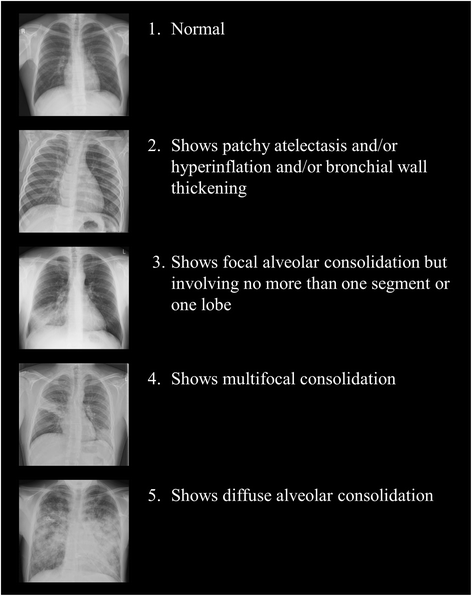A chest radiograph scoring system in patients with severe acute respiratory infection: a validation study
- PMID: 26714630
- PMCID: PMC4696329
- DOI: 10.1186/s12880-015-0103-y
A chest radiograph scoring system in patients with severe acute respiratory infection: a validation study
Abstract
Background: The term severe acute respiratory infection (SARI) encompasses a heterogeneous group of respiratory illnesses. Grading the severity of SARI is currently reliant on indirect disease severity measures such as respiratory and heart rate, and the need for oxygen or intensive care. With the lungs being the primary organ system involved in SARI, chest radiographs (CXRs) are potentially useful for describing disease severity. Our objective was to develop and validate a SARI CXR severity scoring system.
Methods: We completed validation within an active SARI surveillance project, with SARI defined using the World Health Organization case definition of an acute respiratory infection with a history of fever, or measured fever of ≥ 38 °C; and cough; and with onset within the last 10 days; and requiring hospital admission. We randomly selected 250 SARI cases. Admission CXR findings were categorized as: 1 = normal; 2 = patchy atelectasis and/or hyperinflation and/or bronchial wall thickening; 3 = focal consolidation; 4 = multifocal consolidation; and 5 = diffuse alveolar changes. Initially, four radiologists scored CXRs independently. Subsequently, a pediatrician, physician, two residents, two medical students, and a research nurse independently scored CXR reports. Inter-observer reliability was determined using a weighted Kappa (κ) for comparisons between radiologists; radiologists and clinicians; and clinicians. Agreement was defined as moderate (κ > 0.4-0.6), good (κ > 0.6-0.8) and very good (κ > 0.8-1.0).
Results: Agreement between the two pediatric radiologists was very good (κ = 0.83, 95% CI 0.65-1.00) and between the two adult radiologists was good (κ = 0.75, 95% CI 0.57-0. 93). Agreement of the clinicians with the radiologists was moderate-to-good (pediatrician:κ = 0.65; pediatric resident:κ = 0.69; physician:κ = 0.68; resident:κ = 0.67; research nurse:κ = 0.49, medical students: κ = 0.53 and κ = 0.56). Agreement between clinicians was good-to-very good (pediatrician vs. physician:κ = 0.85; vs. pediatric resident:κ = 0.81; vs. medicine resident:κ = 0.76; vs. research nurse:κ = 0.75; vs. medical students:κ = 0.63 and 0.66). Following review of discrepant CXR report scores by clinician pairs, κ values for radiologist-clinician agreement ranged from 0.59 to 0.70 and for clinician-clinician agreement from 0.97 to 0.99.
Conclusions: This five-point CXR scoring tool, suitable for use in poorly- and well-resourced settings and by clinicians of varying experience levels, reliably describes SARI severity. The resulting numerical data enables epidemiological comparisons of SARI severity between different countries and settings.
Figures
Comment in
-
Usefulness of a portable chest radiograph in the initial diagnosis of coronavirus disease 2019.Pol Arch Intern Med. 2020 Oct 29;130(10):906-909. doi: 10.20452/pamw.15512. Epub 2020 Jul 15. Pol Arch Intern Med. 2020. PMID: 32666780 No abstract available.
References
-
- World Health Organization . WHO global technical consultation: global standards and tools for influenza surveillance. Geneva, Switzerland: World Health Organization; 2011.
-
- World Health Organization. WHO global epidemiological surveillance standards for influenza. In. Edited by Influenza WHOWGESSf. Geneva, Switzerland: World Health Organization; 2013
-
- Cox CM, Blanton L, Dhara R, Brammer L, Finelli L. Pandemic influenza A (H1N1) deaths among children--United States, 2009–2010. Clin Infect Dis. 2009;2011(52 Suppl 1):S69–74. - PubMed
Publication types
MeSH terms
Grants and funding
LinkOut - more resources
Full Text Sources
Other Literature Sources




